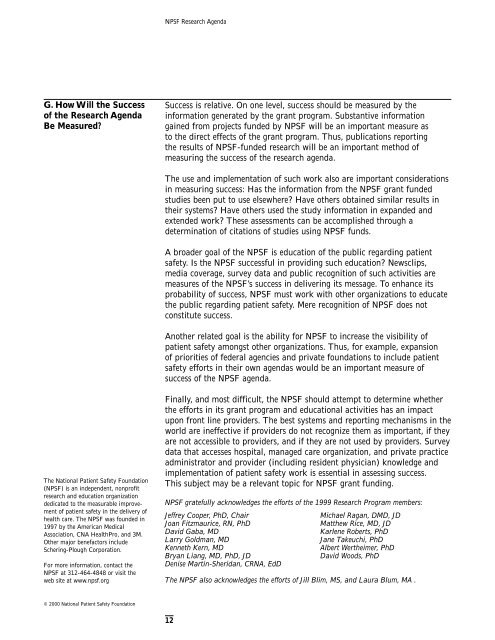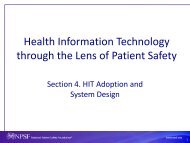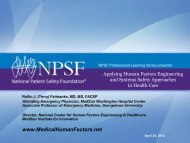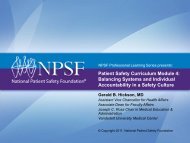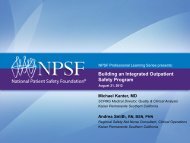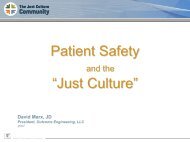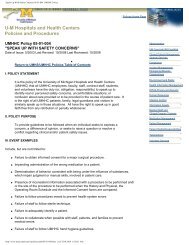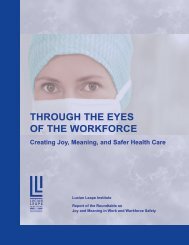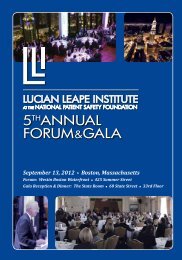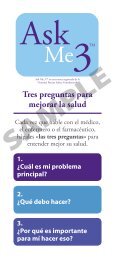Agenda for Research and Development in Patient Safety
Agenda for Research and Development in Patient Safety
Agenda for Research and Development in Patient Safety
- No tags were found...
You also want an ePaper? Increase the reach of your titles
YUMPU automatically turns print PDFs into web optimized ePapers that Google loves.
NPSF <strong>Research</strong> <strong>Agenda</strong>G. How Will the Successof the <strong>Research</strong> <strong>Agenda</strong>Be Measured?Success is relative. On one level, success should be measured by the<strong>in</strong><strong>for</strong>mation generated by the grant program. Substantive <strong>in</strong><strong>for</strong>mationga<strong>in</strong>ed from projects funded by NPSF will be an important measure asto the direct effects of the grant program. Thus, publications report<strong>in</strong>gthe results of NPSF-funded research will be an important method ofmeasur<strong>in</strong>g the success of the research agenda.The use <strong>and</strong> implementation of such work also are important considerations<strong>in</strong> measur<strong>in</strong>g success: Has the <strong>in</strong><strong>for</strong>mation from the NPSF grant fundedstudies been put to use elsewhere? Have others obta<strong>in</strong>ed similar results <strong>in</strong>their systems? Have others used the study <strong>in</strong><strong>for</strong>mation <strong>in</strong> exp<strong>and</strong>ed <strong>and</strong>extended work? These assessments can be accomplished through adeterm<strong>in</strong>ation of citations of studies us<strong>in</strong>g NPSF funds.A broader goal of the NPSF is education of the public regard<strong>in</strong>g patientsafety. Is the NPSF successful <strong>in</strong> provid<strong>in</strong>g such education? Newsclips,media coverage, survey data <strong>and</strong> public recognition of such activities aremeasures of the NPSF’s success <strong>in</strong> deliver<strong>in</strong>g its message. To enhance itsprobability of success, NPSF must work with other organizations to educatethe public regard<strong>in</strong>g patient safety. Mere recognition of NPSF does notconstitute success.Another related goal is the ability <strong>for</strong> NPSF to <strong>in</strong>crease the visibility ofpatient safety amongst other organizations. Thus, <strong>for</strong> example, expansionof priorities of federal agencies <strong>and</strong> private foundations to <strong>in</strong>clude patientsafety ef<strong>for</strong>ts <strong>in</strong> their own agendas would be an important measure ofsuccess of the NPSF agenda.The National <strong>Patient</strong> <strong>Safety</strong> Foundation(NPSF) is an <strong>in</strong>dependent, nonprofitresearch <strong>and</strong> education organizationdedicated to the measurable improvementof patient safety <strong>in</strong> the delivery ofhealth care. The NPSF was founded <strong>in</strong>1997 by the American MedicalAssociation, CNA HealthPro, <strong>and</strong> 3M.Other major benefactors <strong>in</strong>cludeScher<strong>in</strong>g-Plough Corporation.For more <strong>in</strong><strong>for</strong>mation, contact theNPSF at 312-464-4848 or visit theweb site at www.npsf.orgF<strong>in</strong>ally, <strong>and</strong> most difficult, the NPSF should attempt to determ<strong>in</strong>e whetherthe ef<strong>for</strong>ts <strong>in</strong> its grant program <strong>and</strong> educational activities has an impactupon front l<strong>in</strong>e providers. The best systems <strong>and</strong> report<strong>in</strong>g mechanisms <strong>in</strong> theworld are <strong>in</strong>effective if providers do not recognize them as important, if theyare not accessible to providers, <strong>and</strong> if they are not used by providers. Surveydata that accesses hospital, managed care organization, <strong>and</strong> private practiceadm<strong>in</strong>istrator <strong>and</strong> provider (<strong>in</strong>clud<strong>in</strong>g resident physician) knowledge <strong>and</strong>implementation of patient safety work is essential <strong>in</strong> assess<strong>in</strong>g success.This subject may be a relevant topic <strong>for</strong> NPSF grant fund<strong>in</strong>g.NPSF gratefully acknowledges the ef<strong>for</strong>ts of the 1999 <strong>Research</strong> Program members:Jeffrey Cooper, PhD, ChairMichael Ragan, DMD, JDJoan Fitzmaurice, RN, PhDMatthew Rice, MD, JDDavid Gaba, MDKarlene Roberts, PhDLarry Goldman, MDJane Takeuchi, PhDKenneth Kern, MDAlbert Wertheimer, PhDBryan Liang, MD, PhD, JDDavid Woods, PhDDenise Mart<strong>in</strong>-Sheridan, CRNA, EdDThe NPSF also acknowledges the ef<strong>for</strong>ts of Jill Blim, MS, <strong>and</strong> Laura Blum, MA .© 2000 National <strong>Patient</strong> <strong>Safety</strong> Foundation12


